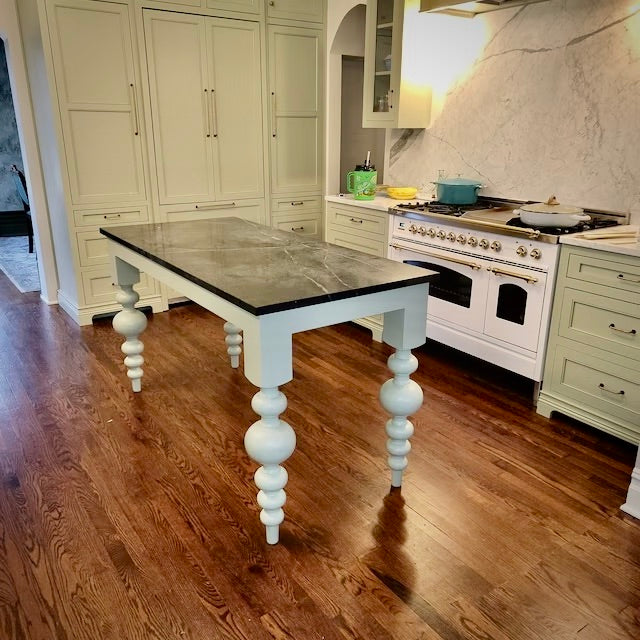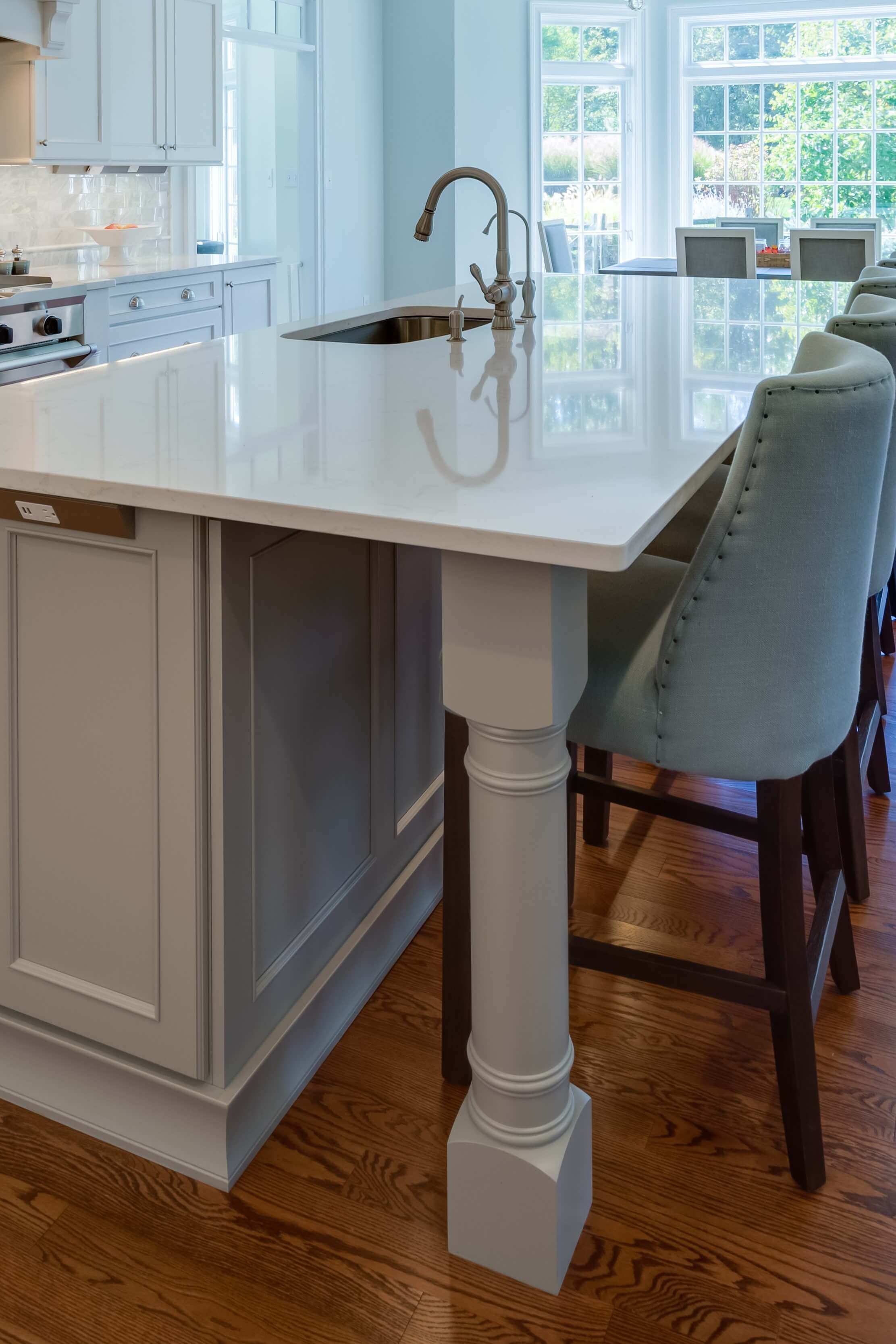Kitchen Island Legs: Improve Your Kitchen with Solid Support
Kitchen Island Legs: Improve Your Kitchen with Solid Support
Blog Article
Crucial Tips for Selecting the Perfect Eating Table for Your Kitchen Area
Selecting the perfect table for your cooking area is even more than just an issue of preference; it demands a complete understanding of your area and requirements. Begin by gauging your available area to make certain sufficient clearance for motion. The form of the table plays a pivotal duty; while rectangle-shaped tables fit larger areas, round ones foster intimacy, and extendable options supply versatility. Material selection is just as critical, with hardwoods offering durability and glass lending a modern touch. The table ought to harmonize with your cooking area's aesthetics and fit your family comfortably. What other elements might influence this vital choice?
Measure Your Area
Selecting the perfect eating table starts with a thorough analysis of your offered space. This foundational step guarantees that the table not just fits easily within the room but also complements the total layout and performance of your dining area.
Take into consideration the circulation of motion around the table. It is important to leave ample room for chairs to be pulled out and for people to walk around the table without obstruction. A basic regulation of thumb is to enable at the very least 36 inches of clearance from the side of the table to the nearby wall or furniture. This makes sure convenience of accessibility and comfort throughout dishes.
Furthermore, think of the number of people you generally entertain and whether you require extra room for guests. Selecting an extendable table can provide adaptability, permitting you to suit varying varieties of restaurants. By accurately measuring your area, you lay the foundation for choosing a table that improves both the aesthetics and capability of your dining location.
Select the Right Forming

On the other hand, round tables are exceptional for smaller sized kitchens or intimate celebrations, as they promote conversation by permitting everybody to face each other. They likewise offer a sense of coziness and can fit well in tighter areas due to their lack of sharp edges. Oval tables use the very best of both worlds, incorporating the length of rectangle-shaped tables with the intimacy of round ones, making them functional for various settings.
Square tables are an additional choice, specifically fit for square-shaped rooms. They develop a contemporary and symmetrical appearance, cultivating an equal eating experience for all seated. However, they might be much less sensible for bigger events unless they feature extensions. Eventually, the form you choose should line up with your area dimensions and way of life to make sure both form and feature.
Material Factors To Consider
When selecting a dining table, material factors to go to this site consider are critical in establishing the table's longevity, maintenance demands, and overall aesthetic. Timber is a traditional option, offering timeless charm and effectiveness.
Glass-topped tables offer a contemporary, sleek look and can make a room appear bigger due to their openness. Nonetheless, they require regular cleaning to stop spots and finger prints. Additionally, solidified glass is recommended for its added strength and safety.

Lastly, composite materials like MDF (Medium-Density Fiberboard) or plywood are economical alternatives. These materials can imitate the appearance of solid timber yet might not offer the very same long life. They are typically easier to clean however can be susceptible to water damages if not effectively secured.
Inevitably, the selection of material should straighten with your kitchen area's style, your way of living requires, and your spending plan restrictions. (kitchen island legs)
Seating Capacity and Convenience
Exactly how do you determine the right seating capacity and convenience for your table? This important action entails examining both the physical room readily available in your cooking area and your family's functional needs. Begin by measuring your kitchen location to make certain the table fits comfortably, allowing at the very least 36 inches of clearance around it for very easy activity. Consider the variety of people who this page usually eat with each other, as this will certainly influence the table size. For a family of four, a rectangle-shaped table of 48 inches long or a round table with a 48-inch size is usually adequate.
The elevation of the table must preferably be around 30 inches, offering a well balanced ergonomic position for seated restaurants. Chairs need to have a seat elevation of 18 to 20 inches to make certain a comfortable eating posture.
Design and Visual Appeal
Picking a table that fits your design and appearance entails stabilizing personal preference with the existing style of your dining area. The dining table is often the focal point of the cooking area, and its layout ought to enhance the total motif of the room. Whether your cooking area boasts a contemporary, minimal look or a rustic, farmhouse appeal, the table you choose must harmonize with these components here are the findings to create a natural and welcoming environment.
Take into consideration products meticulously; timber supplies a classic appeal and can range from rich mahogany for a typical aim to lighter oak for a contemporary feeling. Metal and glass tables, on the other hand, can introduce a smooth, industrial edge to your cooking area. Don't ignore the table's form-- rectangle-shaped tables are functional and classic, while round and oblong options can foster a more intimate eating experience.
Additionally, pay very close attention to surfaces and details. A troubled finish may include personality and heat, whereas a shiny surface can contribute to a clean, modern aesthetic. Eventually, your eating table should not just in shape flawlessly right into your kitchen area's style but also show your individual style, boosting the space both functionally and aesthetically.
Conclusion
In conclusion, selecting the optimal eating table for a kitchen requires mindful analysis of area, form, product, seating capacity, and visual harmony. Ultimately, an appropriate eating table promotes an inviting atmosphere and fits the family conveniently, therefore enhancing the eating experience.

When selecting a dining table, material factors to consider are paramount in establishing the table's durability, upkeep requirements, and general aesthetic. For a household of four, a rectangular table of 48 inches long or a round table with a 48-inch size is normally enough.
Don't overlook the table's form-- rectangle-shaped tables are versatile and traditional, while round and oval options can foster an extra intimate dining experience. kitchen island legs.
Report this page